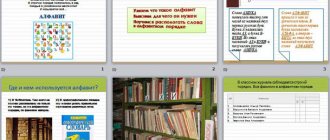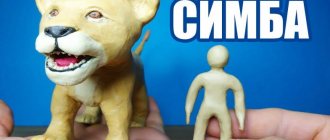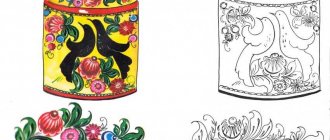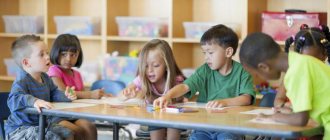Middle group. Junior preschool age. Children 4 - 5 years old
Summary of an open lesson on patriotic education of children of the middle group “The House We Live In” “The House We Live In”
Prepared by teacher Osadchuk N.V. Goal: Expanding children's understanding of their hometown. Objectives: to clarify children’s ideas about their hometown, to introduce them to the sights; cultivate love for your hometown, the desire to maintain cleanliness and order...
Scenario for an open lesson on speech development in a general developmental group of 4–5 years old “In Search of Lost Fairy Tales” “In Search of Lost Fairy Tales”
Goal: -to teach to recognize familiar Russian folk tales with the help of various tasks; - to reinforce with children the names and characters of fairy tales familiar to children, to clarify and enrich children’s knowledge about Russian folk tales; -develop children’s speech, enrich...
Plan for conducting developmental classes with preschoolers 4-6 years old
Social and psychological support programs:
- development of mental processes (attention, memory, perception, thinking)
- development of the emotional-volitional sphere of preschool children
- development of creative thinking, artistic abilities and fine motor skills
- reduction of hyperactivity
- learning to manage your emotions, developing proper communication skills, reducing the level of aggression.
Main goals Ways of implementation Methodological materials development of fine motor skills games with mosaics, dot drawings, assembling construction sets, modeling mosaic, constructor, paper, pencils, plasticine development of attention and perseverance, spatial orientation complete the drawing or find the missing details of the image, assemble puzzles, cups with pictures games for finding objects and placing them
puzzles, cubes, drawings (samples) other small items, toys
development of short-term memory lay out the pictures (objects), close them and ask the child to repeat the row any objects, pictures development of integrity of perception, understanding of the subject contour images of animals, objects - guess what it is and color it outline images, pencils development of logical thinking laying out a series of pictures: from large to small, by color, find the extra picture series of pictures development of creative potential, the ability to assemble parts into a whole assembling a whole meaningful object from designer parts different types of construction sets (trains) teaching the concept of geometric shapes games with geometric shapes set of pictures with figures training perseverance, relieving symptoms of hyperactivity games aimed at concentration ball, sticks, cubes, soft toys learning to express emotions, the ability to transform into another person (animal) play theater based on fairy tales (“Teremok”, “Turnip”) fairy tale props teaching the basics of mathematical knowledge Counting to 10 and back, examples of addition and subtraction Cubes with numbers, teaching aids teaching basic reading Games with sounds and letters, drawing letters, adding words Teaching aids, cubes with numbers, paper, colored pencils. increased self-confidence and sense of security.
Basic socio-pedagogical and psychological skills of children of middle and senior preschool age:
- Special skills and abilities:
Math knowledge:
- counting to ten in ascending and descending order, the ability to recognize numbers in a row and separately, quantitative (one, two, three...) and ordinal (first, second, third...) numerals from one to ten;
- previous and subsequent numbers within one ten, the ability to compose numbers of the first ten;
- recognize and depict basic geometric shapes (triangle, quadrangle, circle);
- shares, the ability to divide an object into 2-4 equal parts;
- basics of measurement: a child must be able to measure length, width, height using a string or sticks;
- comparison of objects: more - less, wider - narrower, higher - lower;
- the basics of computer science, which include an understanding of the following concepts: algorithms, information coding, a computer, a program that controls a computer, the formation of basic logical operations - “not”, “and”, “or”, etc.
- Development of fine motor skills:
From 4 to 6 years old, a child should be able to:
— build a bridge from 5 cubes
- draw a cross
- draw a square
— draw a man (3-6 elements)
- Psychological characteristics:
- Perception
By older preschool age, it becomes more perfect, meaningful, purposeful, and analytical. It highlights voluntary actions - observation, examination, search. Children know the primary colors and their shades, and can describe an object by shape and size. They learn a system of sensory standards (round like an apple).
- Memory.
Involuntary memory should be gradually replaced by voluntary memory; children learn to remember at will. In middle preschool age (between 4 and 5 years), voluntary memory begins to form. For a 6-year-old child, such a task is quite accessible - remember 10 words that are not related in meaning.
- Thinking.
Visual-effective thinking (manipulation of objects) is improved, visual-figurative thinking (manipulation of images and ideas) is improved. For example, children of this age can already understand what a room plan is. Using the group room diagram, children can find the hidden toy. The games “Find the treasure” and “Labyrinths” are useful. And the prerequisites for logical thinking begin to actively form, which is finally formed by the age of 14. The ability for induction and deduction develops.
- Attention.
An important indicator of the development of attention is that action according to the rule appears in the child’s activities - the first necessary element of voluntary attention. A child of 5-6 years old should be able to concentrate on necessary, but not interesting, activities for at least 5-10 minutes.
- Speech
.
The sound side
develops .
Younger preschoolers begin to realize the peculiarities of their pronunciation. The vocabulary
is growing rapidly .
The grammatical structure
develops . Children learn morphological (word structure) and syntactic (phrase structure) patterns.
- Imagination:
becomes active - voluntary. Imagination also plays another role - affective and protective. It protects the growing soul of the child from excessively difficult experiences and traumas.
- Features of the personal characteristics of a preschooler:
- Emotional sphere.
By older preschool age, the structure of the emotional processes themselves changes. In early childhood, they included vegetative and motor reactions. The external expression of emotion becomes more restrained in some children. The child begins to be happy and sad not only about what he is doing at the moment, but also about what he still has to do.
- Motivational sphere.
The most important personal mechanism formed during this period is the subordination of motives. It appears at the beginning of preschool age and then develops consistently. If several desires arose simultaneously, the child found himself in an almost insoluble situation of choice. The strongest motive for a preschooler is encouragement and receiving a reward. A weaker one is punishment, an even weaker one is the child’s own promise.
- Preschooler starts internalize ethical standards
accepted in society.
He learns to evaluate actions from the point of view of moral norms, to subordinate his behavior to these norms, and he develops ethical experiences. Initially, the child evaluates only the actions of others - other children or literary heroes, without being able to evaluate his own. In middle preschool age, the child evaluates the actions of the hero regardless of how he treats him, and
can justify his assessment based on the relationships of the characters in the fairy tale. In the second half of preschool childhood, the child acquires the ability to evaluate his own behavior and tries to act in accordance with the moral standards that he learns. - Self-awareness
is formed by the end of preschool age due to intensive intellectual and personal development, it is usually considered the central new formation of preschool childhood. Self-esteem appears in the second half of the period on the basis of an initial purely emotional self-esteem (“I am good”) and a rational assessment of other people’s behavior. The child first acquires the ability to evaluate the actions of other children, and then his own actions, moral qualities and skills. By the age of 7, most self-esteem of skills becomes more adequate. Another line of development of self-awareness is awareness of one’s experiences. At the end of preschool age, he orients himself in his emotional states and can express them in words: “I’m happy,” “I’m upset,” “I’m angry.”
Plan for individual lessons (or small group lessons) with preschoolers
Lesson 1.
Testing the children with whom classes will be conducted to identify existing general and special skills and abilities, drawing up a more specific lesson plan taking into account the areas of work.
Lesson 2.
Development of a child's fine motor skills.
The game “Mosaic” is to put together a picture using parts of a plastic mosaic according to a sample. Time - 15 minutes.
The game “Collect peas” - the peas are placed in a jar of cereal, the task is to “catch” all the peas with your hands and put them in another bowl. Time - 10 minutes.
The game “Connect the dots” - the dots indicate the outline of the drawing, the task is to circle the dots so that the outline is complete. Time - 10 minutes.
Mobile physical education (finger gymnastics) - 10 minutes.
The game “Make a Hedgehog” - the task is given to make an animal figurine from plasticine according to the model. Time - 15 minutes.
Lesson 3.
Development of spatial orientation skills.
The game “Complete the picture” is a task to determine what is missing from the image in the picture and complete the missing detail. Time - 10 minutes.
The game “Assemble the puzzle” is a task to assemble a picture from parts. Time - 20 minutes.
Mobile physical education (finger gymnastics) - 10 minutes.
The game “Place in order” - the order of placing objects is spelled out, for example, put the red cube on the blue one, and the green one behind the red one (option: “draw a dot on the paper in the upper right corner”) and a task is given to complete. Time - 20 minutes.
Lesson 4.
Development of memory, perception, thinking.
Game “Guess Who” - outline images of objects are given, you have to guess what it is and color it. Time - 15 minutes.
The game “Select the right one” - you are given drawings of objects drawn on top of each other, you need to find a specific image. Time - 15 minutes.
Mobile physical education (finger gymnastics) - 10 minutes.
The game “What has changed” - objects are laid out, the child is asked to remember and turn away. Then the order of objects is changed, new ones are added or old ones are removed. The child must say what has changed. Time - 20 minutes.
Lesson 5.
Development of logical thinking.
The game “Place in order” - objects (pictures) are given that need to be arranged in order - from largest to smallest, from thick to thin, etc. Time - 15 minutes.
Game “Find the odd one out” - there is an object in the picture that is not included in the group (for example, a lemon in a bowl). We need to find him. Time - 10 minutes.
Mobile physical education (finger gymnastics) - 10 minutes.
Game “Guess” - a picture is shown with a separate image of objects (for example, a wheel, steering wheel) - what is this? Time - 10 minutes.
Game “Counting Sticks” - tasks for using counting sticks, for example:
- Lay out a square, triangle, rectangle;
- count the number of sticks in each figure;
- name the geometric shapes that make up the figure;
- count the geometric shapes that make up the overall figure (how many triangles? squares?);
- count the angles included in the figure;
- build a figure according to the model;
- come up with and put together the figure yourself.
Time - 15 minutes.
Lesson 6.
Development of creative potential.
The game “Assemble a figure” is to assemble several different figures from the proposed construction set. Time - 20 minutes.
Mobile physical education (finger gymnastics) - 10 minutes.
Game “Imagine an Animal” - come up with and draw (with paints, pencils) a fairy-tale animal. Time - 15 minutes.
The game “Pretend an Animal” is to use movements and sounds to show an animal, real or imagined. Time - 15 minutes.
Lesson 7.
Teaching concepts of geometric shapes.
Game “Name the Shape” - images of geometric shapes are shown, you need to name them and say what they look like. Time - 15 minutes.
Game “Make an Animal” - the task is given to make an animal from geometric shapes of different sizes. Time - 15 minutes.
Mobile physical education (finger gymnastics) - 10 minutes.
Game "Volume" - the concepts of flat and three-dimensional figures are given, what three-dimensional figures look like. Time - 20 minutes.
Lesson 8.
Training in perseverance and concentration.
Game “Remember” - on the count of 1, you need to raise your arms to the sides, 2 - up above your head, 3 - clap your hands, 4 - lower your hands down. The child does an exercise. The pace gradually increases. Time - 10 minutes.
Game “Complete the task” - the task is spoken out, for example, you need to sequentially clap your hands, sit on a chair, and close your eyes. Upon signal, all tasks are completed. The tasks gradually become more difficult. Time - 15 minutes.
Mobile physical education (finger gymnastics) - 10 minutes.
The game “Cross out the object” - you are given a sheet of paper with drawn icons that need to be crossed out. Time - 10 minutes.
The game “Catch the Number” - different numbers are called, for example, upon hearing 5, the child claps his hands. Time - 5 minutes.
The game “Collect the red ones” - from the scattered colored pieces of paper you need to choose only the red ones, for example. Time - 10 minutes.
Lesson 10.
Teaching the basics of counting.
Game “Fun Problems” - a small task is spoken out, for example: Kolya bought a red ball, and Dima bought 2 green ones. How many balls do they have in total? Time - 10 minutes.
The game “Find the Number” - the drawn number is “hidden” in the picture, you need to find it, also guess by touch, by drawing with your finger on the back, etc. Time - 10 minutes.
Game “Find a Pair” - you are asked to find an object similar to the one proposed: in color, shape, size, etc. Time - 10 minutes.
Mobile physical education (finger gymnastics) - 10 minutes.
Game "Matryoshka" - a set of nesting dolls is asked to be counted, collected and placed in order. Time - 10 minutes.
Game “Count” - how many items are there? We count, add, subtract. Time - 10 minutes.
Lesson 11.
Teaching the basics of reading (for older preschoolers).
The game “Find the Letter” - different letters are “hidden” under different images, you need to find it and guess it. Time - 15 minutes.
The game “Finish the word” is called a syllable, for example, KA. A ball is thrown to the child and he must finish the word (KA-SHA, KA-TYA). Time - 15 minutes.
Mobile physical education (finger gymnastics) - 10 minutes.
Game “Guess the sound” - words that are similar in sound are called, you need to choose the odd one out. For example:
NORA, NORA,
IT'S TIME , NORA. EAR, EAR, EAR, HAIR . SPIT , GOAT, GOAT, GOAT. BOW, BOW, PLOW , BOW. CAP, CAP , CAP, CAP. MOLE, MOLE, MOUTH , MOLE. CAT, YEAR , CAT, CAT. HONEY, HONEY, HONEY, ICE . WALRUS, CORZH , WALRUS, WALRUS. FISHING FISHING FISHING FISHING FISHING FISHING FISHING FISHING FISHING FISHING FISHING FISHING FISHING FISHING FISHING FISHING FISHING FISHING FISHING BOUQUET, BOUQUET, BOUQUET, COUPLET . HERON, HERON, DROP , HERON. HOUSE, HOUSE, HOUSE, VOLUME . DAUGHTER, PERIOD , DAUGHTER, DAUGHTER. CANE , NAIL, NAIL, NAIL.
Time - 10 minutes.
The game “Guess the Syllables” - the child is taught to distinguish syllables, clap their hands as many times as the number of syllables he hears. Time - 10 minutes.
Lesson 12.
Development of fine motor skills, attention, perseverance.
The game “Unravel the Path” - you are asked to unravel the drawn labyrinth (the squirrel is looking for a fungus). Time - 15 minutes.
Game “Complete the object” - half of the object is drawn and you are asked to complete the rest. Time - 15 minutes.
The game “Do the same” - a pattern (object) is made from a mosaic or construction set - it is proposed to be repeated. Time - 10 minutes.
Mobile physical education (finger gymnastics) - 10 minutes.
The game “What’s missing” - a drawing is given of an object that is missing a part (a horse’s tail). The child must determine what is missing and fill it in. Time - 10 minutes.
Open classes. Notes – Notes of an open lesson in the middle group “Rays of Health”
Publication “Summary of an open lesson in the middle group “Rays...”
Summary of an open lesson in the middle group on the topic: “Rays of Health” Goal: to continue to form children’s ideas about health and a healthy lifestyle. Objectives: Educational: to form preschoolers’ ideas about the dependence of health on hygiene, daily routine,…
Summary of an open lesson for the middle group “Mom is a precious word” for Mother’s Day Direction: social and personal development Educational area: “Socialization” Integration: artistic and aesthetic development, speech development. Goal: to cultivate a feeling of love for mom through exposure to works of art (literature, music, painting, in which...
Summary of an open lesson on speech development in the middle group “Winter-Winter” Goal: Development of coherent, dialogical and monologue speech. Objectives: Educational: Clarify and expand the understanding of winter, winter phenomena, winter fun, adaptation of animals to winter; develop the ability to coordinate nouns with adjectives; form...
Summary of an open lesson on design in the middle group "Teremok" MBDOU BCR d/s "Zhuravushka" RP Blagoveshchenka Lesson on design in the middle group "Teremok" Educator: Yulia Vladimirovna Suslova 2022 Integration of OO: "social-communicative development", "cognitive development" , “speech development”. Program objectives: To develop the ability...





